Introduction: Welcome to Rhodes, Greece!
Rhodes is an island in Greece that is home to a wealth of different cultures, each with its unique history. The city of Rhodes has been shaped by the contributions made by these cultures and a result is a beautiful place that is rich in historical heritage.
While Rhodes is small enough to be easily explored, it still manages to offer a wide range of beaches, settlements, natural wonders, and historical sites, as well as numerous opportunities for unforgettable experiences and the friendliest of locals. The sun is out more than 300 days a year in this part of the world.
When visiting Rhodes, Greece, it’s important to know how to maximize your time there. In addition to the more well-known tourist attractions, there are some hidden gems worth exploring, regardless of your personal preferences.
You will find a lot of ancient buildings in Rhodes, and you will also find that the locals are very welcoming and friendly. There is plenty to do and see while you are there, so make sure to plan your trip ahead of time! Rhodes is a great place to visit!
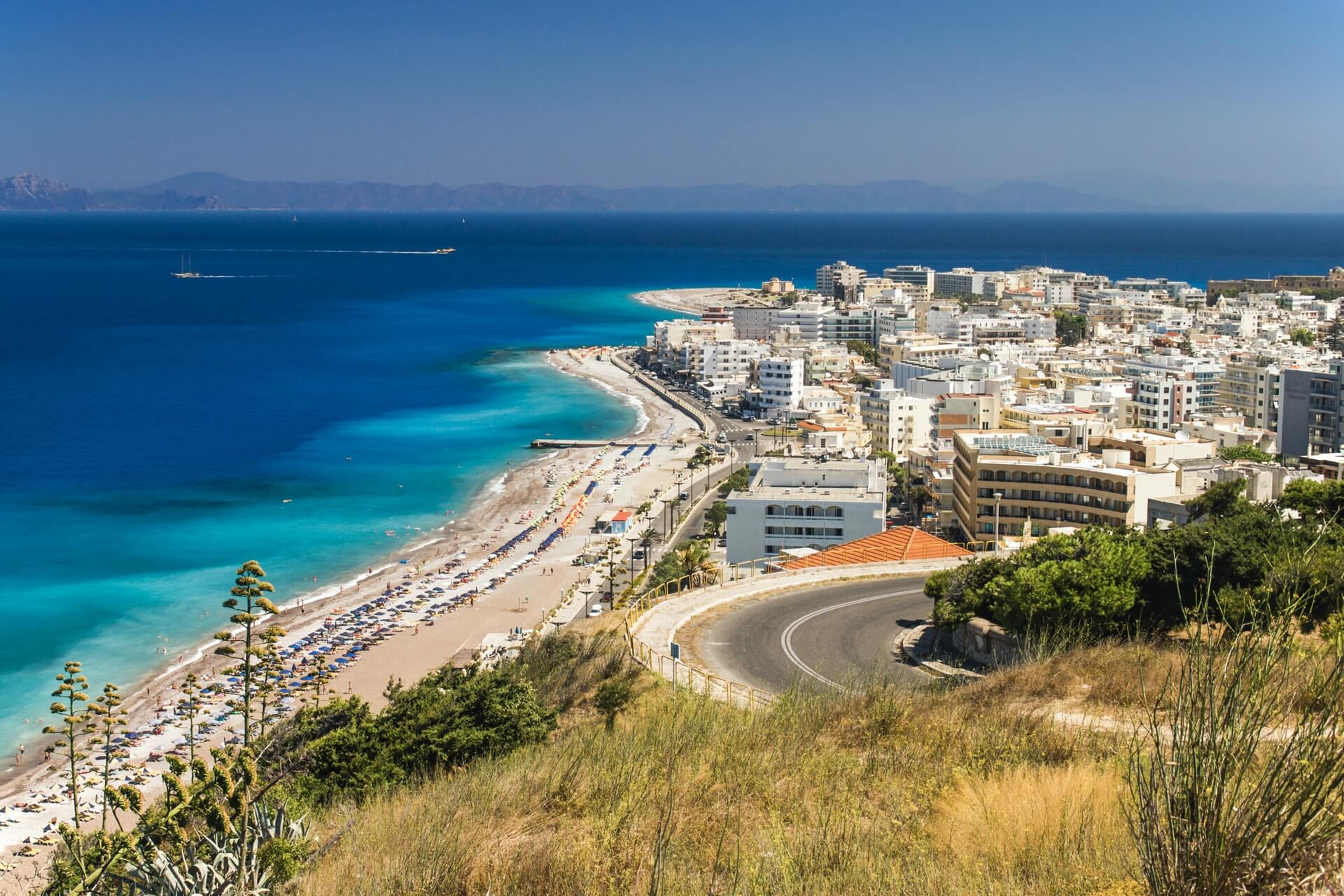
Why Should You Visit Rhodes, Greece?
Rhodes is an island in Greece, located in the eastern Aegean Sea. It is one of the Dodecanese islands. The island has been inhabited since prehistoric times. One of the most important historic sites on the island is the Palace of Grand Master, which was constructed by Knights Hospitaller in 1522. Rhodes has a rich history and culture that visitors can explore when they visit the city. The city has plenty of hotels to choose from and many restaurants and cafes to enjoy while exploring this beautiful destination.
It has a long and colorful past.
Rhode, a sea nymph and goddess of the sea, is said to have protected the island in Greek mythology. She married Helios, a sun god who had a falling out with Zeus, the head of the ancient Greek gods when she arrived in Rhodes. What better place to hear this tale than in the very place where it is said to have taken place all those years ago? This ancient site is a must-see on any Rhodes vacation, and it’s not to be missed. The Temple of Athena Lindia, built in the 4th century, is dedicated to the goddess Athena and is located on the Acropolis of Lindos.
Because of the stunning sands.
The island of Rhodes is a stunning mix of mountainous terrain, ancient ruins, and miles of golden sands. The sandy Vlycha Bay on Rhodes’ sun-drenched eastern coast is known for its calm atmosphere and emerald-green waters. A 10-minute walk from the Acropolis of Lindos, you’ll find the coastal town’s main beach at St Paul’s Bay surrounded by picturesque scenery. South of the city center lies Glystra Beach, which features sun loungers and parasols, showers, and a cafe as well as a high-rise resort. Another worthwhile stop is Tsambika, which offers a view of the monastery.
In addition to going hiking, there’s going to be a lot of wine
Mount Atáviros, Rhodes’ highest point, is just shy of 1,200 meters. With a 6-hour ascent from the mountain village of Émbonas (the largest settlement in the region), only experienced hikers should attempt this route. If you manage to climb to the top, you’ll be rewarded with breathtaking views. If you’ve made it back to the village, don’t forget to reward yourself with a glass of wine (or two) from the local vineyards.
It is home to the oldest inhabited medieval city in Europe
The oldest continuously inhabited medieval city in Europe lies beyond the walls of Rhodes’ charming Old Town. Since around 1309, it has been occupied alternately by the Turks and the Italians. Cobbled streets lead to the lower town where you’ll find Ottoman baths, mosques, and public buildings alongside Byzantine churches. It has been designated a World Heritage Site by the United Nations. Get lost amongst the quaint shops and cafes lining the cobbled streets.
To eat local crusaine
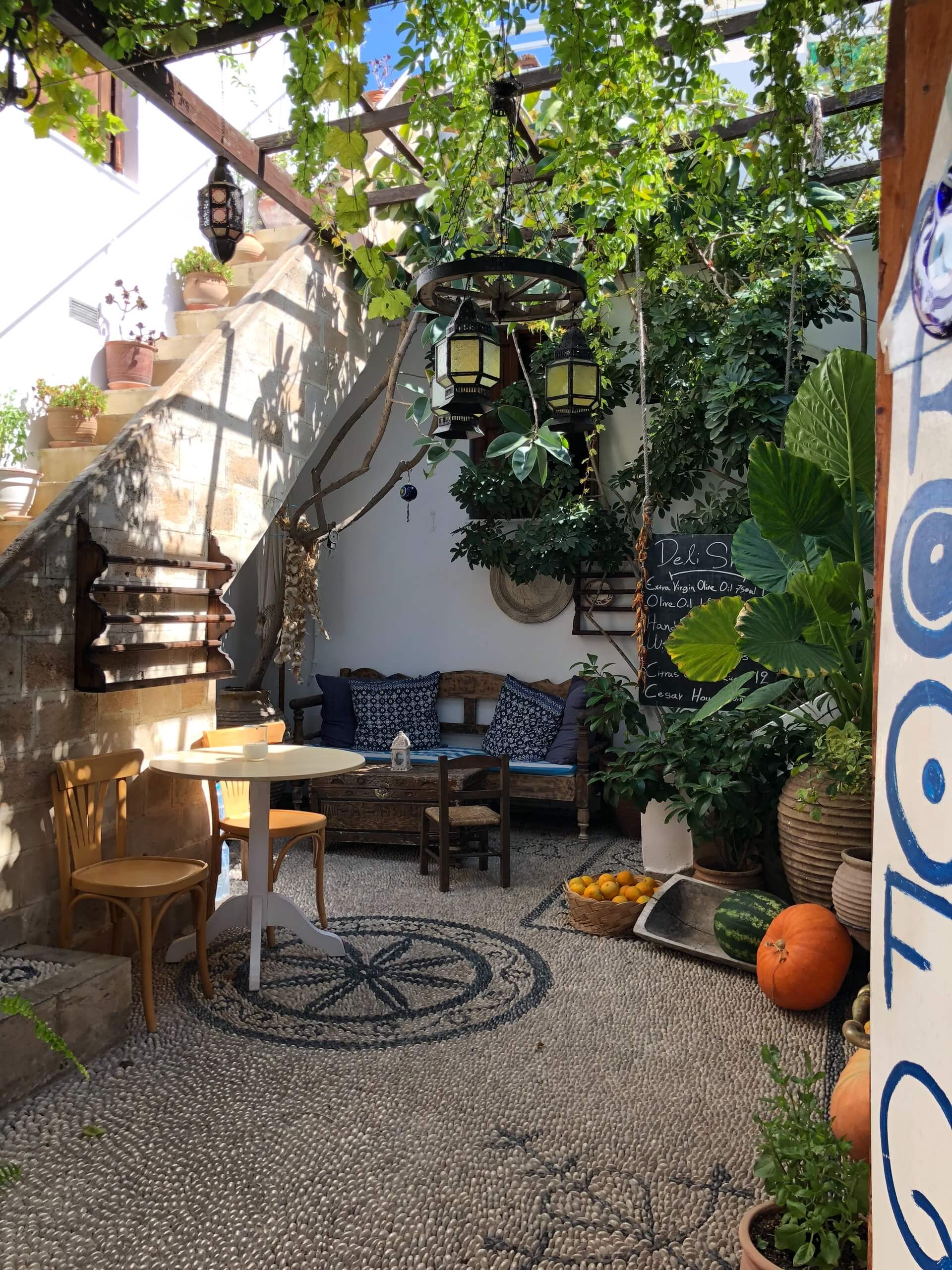
There are many Greek islands, but this one stands out for its abundance of local produce and charm. The Marco Polo Cafe is a top-rated dining option in Rhodes City. Fine diners spill out into a lemon-scented twinkling garden courtyard, where you can expect sea bream, octopus, and pork loins cooked in unique ways. Megiston or Niohori, run by the butcher across the street, are two authentic Greek tavernas to try.
The Best Things To Do on the Greek Island of Rhodes
Rhodes, the Dodecanese Islands’ capital island, is situated in the Aegean Sea off the coast of Greece’s southeast coast. As one of the Greek islands with airports, it is accessible from all over the globe. During the peak season, it can be quite crowded.
Climb the Lindos Acropolis
The Acropolis of Lindos, one of Greece’s most important archaeological sites, rises above the modern town of Lindos. Byzantine fortifications were already in place when, in the 14th century, the citadel’s Knights of St John built the Castle of St. John on them. The citadel’s history, on the other hand, goes back much further. You will come across a 2nd century BC ship carved into the rock if you continue down the steep footpath. This temple, which was built in the 4th century BC, has Doric columns that can be seen from the top. The view from the Acropolis, which rises 116 meters (381 feet) above the sea, is spectacular. If you go in the summer, bring a hat and water because there is virtually no cover. Relax on Lindos Beach in the Mediterranean after a day of cultural exploration in Lindos.
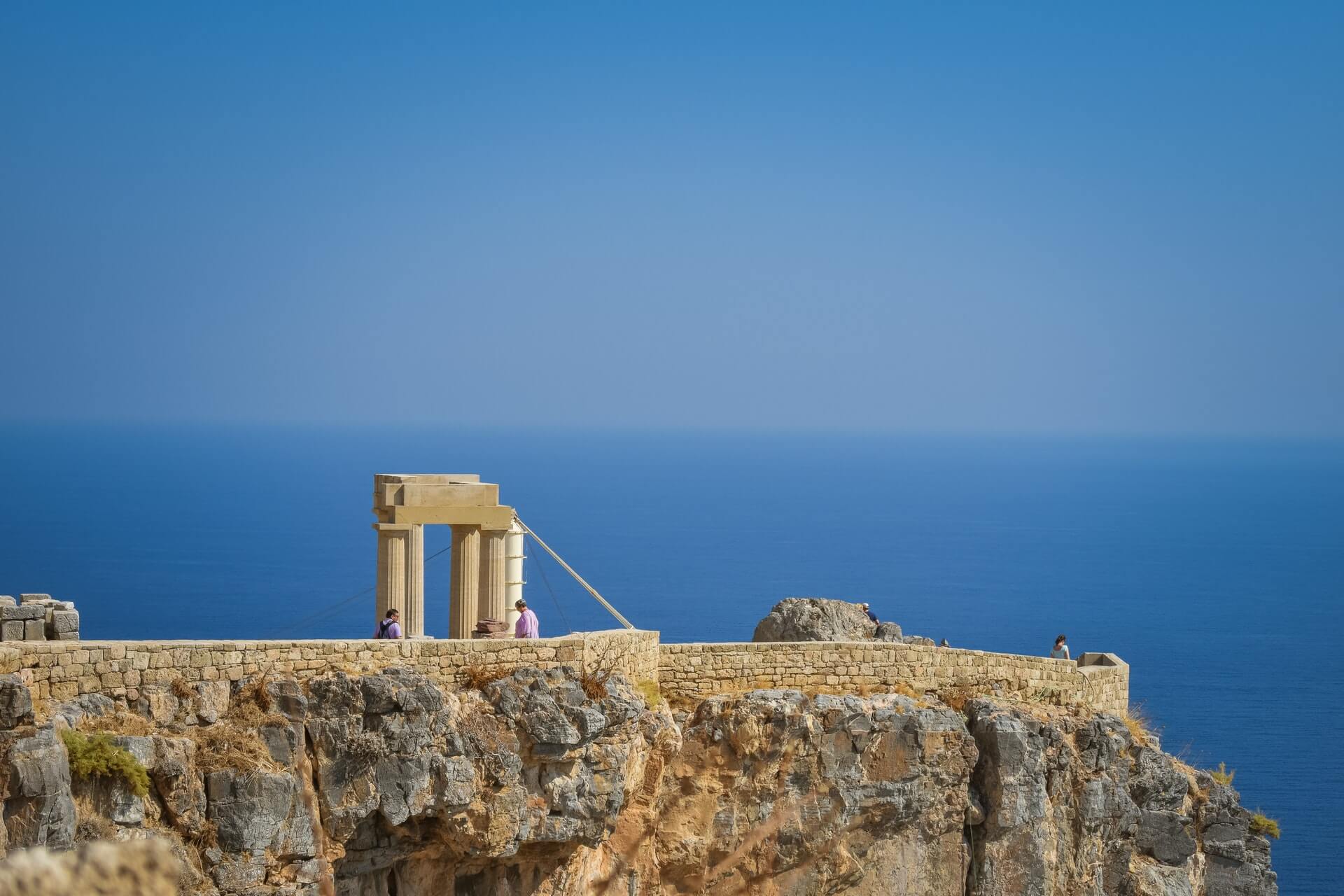
Acropolis, Lyndos, Greece
Take a trip to the port of Mandraki.
You can visit Mandraki after exploring the old town of Rhodes. This is the more up-to-date section of town. Mandraki Port is Rhodes Town’s northernmost port. The Fort of Sint-Nicolas can be reached via a long pier on the port’s east side.
The three mills of Rhodes can be seen from the harbor, as well as the site where the Colossus of Rhodes was constructed. In 226 BC, an earthquake destroyed the 30-meter-tall statue of the sun god Helios. In its place, two small statues of deer and roe deer were placed. Since then, it has been Rhodes’ most recognizable symbol. The two columns at the entrance to the harbor are adorned with these statues. In comparison to the Colossus, of course, they are not as impressive. It was considered one of the Seven Wonders of the World at the time of its construction. Explore the Rhodes Archaeological Museum.
The Archaeological Museum of Rhodes is housed in a medieval building with porticoes, built-in 1440, that was once the Hospital of the Knights of St. John. Classical, Hellenistic, and Roman sculptures, as well as other artifacts from the island’s past, are on display. While you’re there, take some time to look at the museum’s Hellenistic-era mosaic floors.
The Grand Master’s Palace in Rhodes
Gothic architecture is rare in Greece, and this castle is one of the few remaining examples in the country. As a Byzantine citadel in the 7th century, it is part of Rhodes Town’s World Heritage Site. The Knights Hospitaller occupied the fortress in the 14th century and used it as their headquarters. The grandmasters of the order were able to enjoy a lavish lifestyle there.
Explore the Rhodes Archaeological Museum.
The Archaeological Museum of Rhodes is located in a medieval building with porticoes dating back to 1440, which used to be the Hospital of St. John’s Knights. Classical, Hellenistic, and Roman sculptures, as well as other artifacts from the island’s past, are on display. While you’re there, take some time to look at the museum’s Hellenistic-era mosaic floors.
Rhodes’s colossus of a building.
One of the Seven Wonders of the Ancient World was the Colossus of Rhodes or Rhodes. Greek sun-god Helios, who was worshiped by the Greeks and later combined with the god of light Apollo to form the Colossus, was sculpted in bronze. The colossus has vanished from view.
The gods were thanked for Rhodes’ victory over Demetrius Poliorcetes’ (305 BCE) long siege by a huge bronze/stone-carved statue.
The Colossus of Rhodes wasn’t just a massive statue, as some may have mistakenly assumed. It was a symbol of the people’s unity on the Mediterranean island of Rhodes. The well-known symbol of Rhodes now stands on the alleged site of this enormous statue with one foot on each side of the gate. Both of the bronze deer.
Kallithea Thermal Springs is a great place to relax
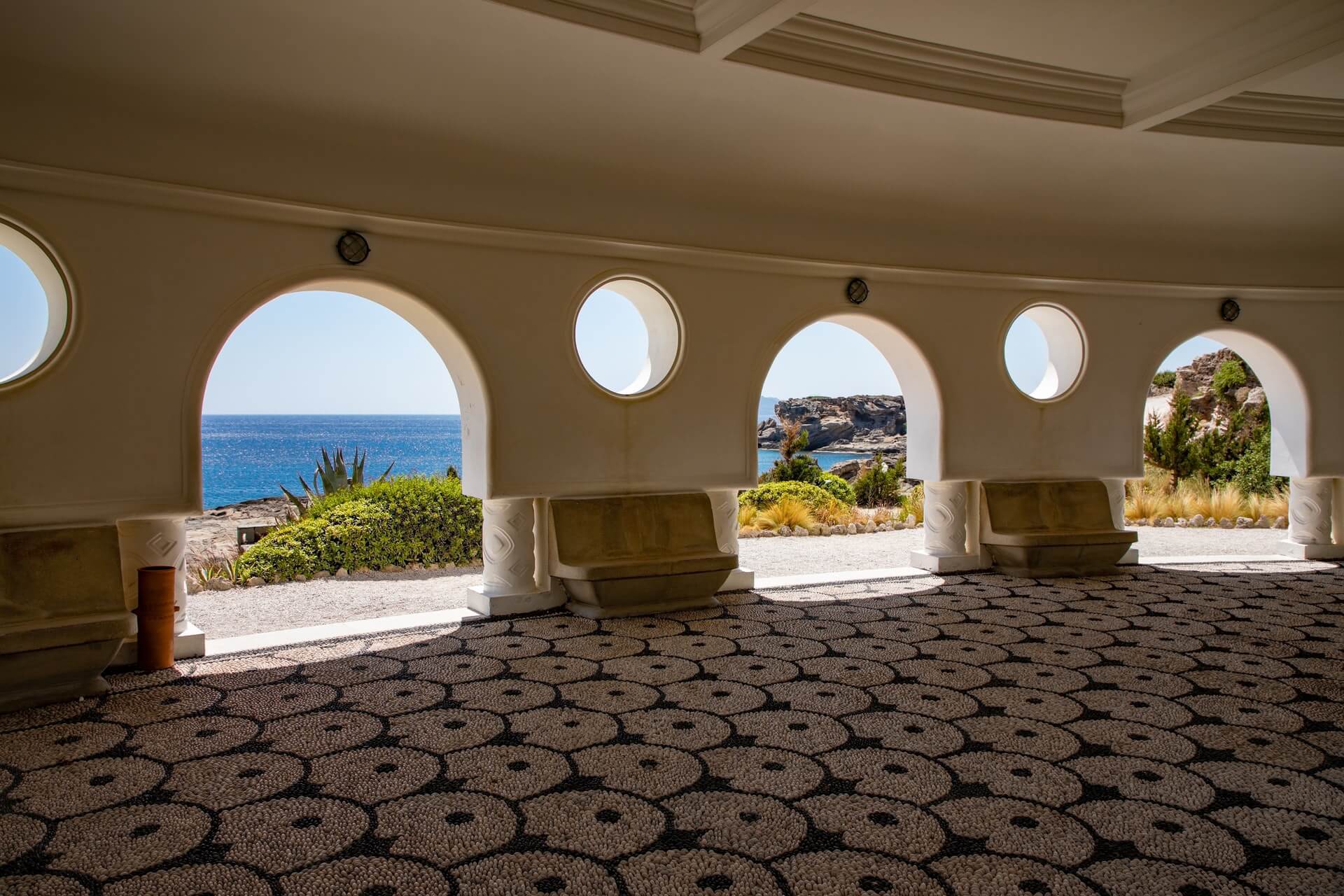
Kallithea Springs
During the Italian occupation, the Kallithea Thermal Springs, located 9 kilometers (5.6 miles) south of Rhodes Town, first opened its doors in 1929. Pebblestone mosaics, lush landscaping, and expansive patios adorn the opulent complex. Even though Kallithea is a stunningly beautiful and budget-friendly place to spend some time, it also has healing properties thanks to its thermal springs and low entry fee of just 3 euros (£2.60).
The Valley of the Butterfly
The Valley of the Butterflies is located on Rhodes’ western coast, about three miles southeast of the village of Theologos (or Tholos). Butterfly Valley is another name for Butterfly Valley. This is one of the island’s most popular tourist hotspots for good reason.
The “Zitia” tree can be seen in the Valley of the Butterflies (Petaloudes). Only a few areas of the Mediterranean are home to this rare species. The shady, wet trails are home to millions of butterflies, which flutter about peacefully. Streams are used to create this area’s lakes and smaller waterfalls.
Thousands of butterflies of the Panaxia genus (specifically Quadripunctaria Poda) swarm into the butterfly valley in August to mate. Visitors should be allowed to enjoy watching the butterflies rest, but disturbing them in any way is strictly prohibited. Kameiros
Location: Rhodes Island’s Kamiros archaeological site is situated on the island’s west coast. Nearly 36 miles from the center of Rhodes City. This was the smallest of the three most important cities at the time, Kamiros being the fourth.
Wine and olive oil were produced in Kamiros, a small agricultural town. The author Homer even referred to this in his works. During the Hellenistic period in 226 BC, the city of Kamiros was completely rebuilt following a devastating earthquake. Before that, the city had been around since the Archaic era. As far back as prehistoric times, the Mycenaeans had occupied Kameiros, Rhodes’ largest urban center, on the island.
On a board at Prasonisi
Rhodes’ southernmost point is Prasonisi. For kitesurfers and surfers, Prasonisi (green island) is a great spot because of the windy conditions on the beach. The sand is fine and soft, so if you just want to sit back and watch the surfers, there are plenty of places to do so. Because of the gentle sand and calm waters, Prasonisi is a favorite amongst families.
How many days do you need in Rhodes Greece?
Rhodes Greece is a popular tourist destination, but it is not always the cheapest. Many factors influence the price of your vacation, so you should do some research beforehand.
The average time people spend in Rhodes Greece is six days. It also discusses other factors that influence the cost of your trip, such as the time of year and how many people are traveling with you. Since Rhodes is the largest Dodecanese island, you might need a few days to explore it from end to end. You will need at least 4-5 days to visit all major attractions, along with the island’s smaller villages.
What is the best month to go to Rhodes?
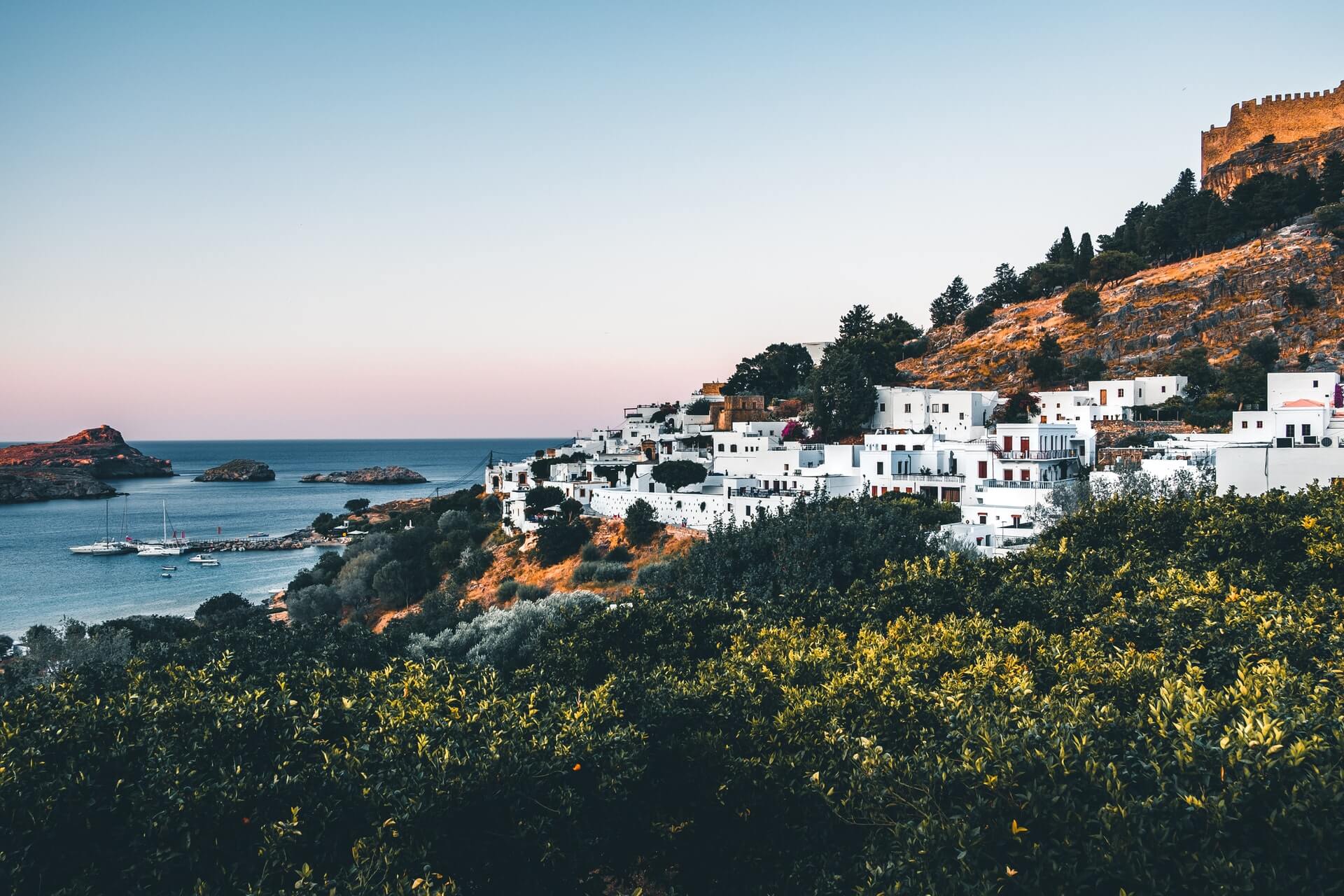
Rhodes, a Greek island, enjoys an average of 300 sunny days per year. With up to 13 hours of sunlight per day, summer is the best time to visiting Rhodes , Greece.
Temperature 25°C average in June and September, with a high of 27°C in August, is to be expected. You may see a heatwave from the Sahara Desert in North Africa while you’re there. Prepare for temperatures in the high 30s if this occurs, so don’t forget your sunscreen.
It’s almost unheard of to get rain in the summer, which is great if you plan to spend your days on the beach soaking up the sun. For those who find the summer heat unbearable, you may want to plan a trip during the fall or winter months, when the weather is still hot but more manageable.
At the beginning of autumn, Rhodes’ temperatures are around 21°C and gradually drop to 18°C in November. Lows of 14°C are expected at night, so you may want to bring a light jacket. In October, Rhodes receives 68mm of rain, and in November, it receives 105mm of rain.
Rhodes experiences winter temperatures of 13°C between December and February, with the wettest month being December with 141mm of rain. In the fall, the water is about 21°C, but in January, it is only 17°C, which is far too cold to go swimming. In the spring, the daily average temperature rises to around 17°C in March, with maximum temperatures of 23°C by the end of May.
It’s a great time of year to take advantage of the sunshine hours, which in the spring average over 11 hours per day. There is 81mm of rain a month at the beginning of the season and 9mm in May, so you might want to bring a raincoat.
Nightlife on Rhodes Island
The nightlife on Rhodes Island is legendary, and the island is known as Greece’s most cosmopolitan, with something for everyone. A wide variety of nightlife options are available throughout the day and into the early hours of the morning. The majority of Rhodes’ nightlife can be found in the old town of Rhodes and the tourist resorts of Faliraki and Lindos.
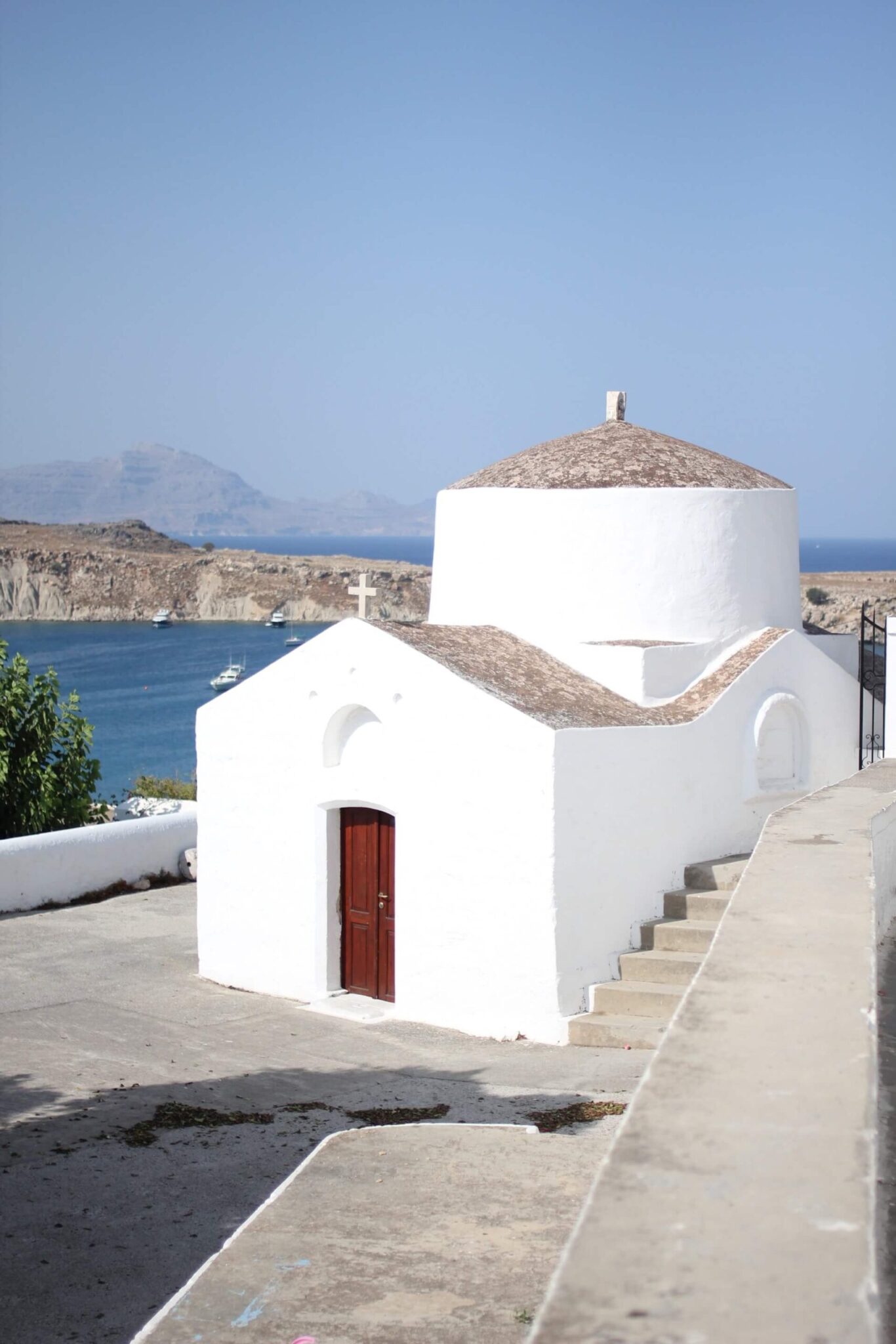
Lindos, Greece
In Rhodes Town, the island’s largest city, there are plenty of bars and clubs to keep the party going late into the night. Bars and tavernas line the harbor. New Town has a wide variety of clubs and discos, as well as traditional bouzouki establishments that feature Greek music. Eli Beach Bar is a local favorite for watching the sunset while sipping on one of their many delicious cocktails.
Rhodes’ famous bar street is just a short walk from the city’s new town center. It’s easy to find a disco bar with a wide range of musical genres and other entertainment options. At Colorado, you can sip a drink while listening to live bands perform commercial rock on the first floor, while on the second floor, you can unleash your inner DJ on the island’s most popular tunes.
We recommend visiting the square Kyprou, where you’ll find several lounge bars serving excellent cocktails and relaxing music. In the old town, you can find some great Latino restaurants with a tune Latin music.
Zobraziť tento príspevok na Instagrame
What you Should Know about the Cuisine before Visiting Rhodes, Greece
The cuisine of the Rhodian Islands is influenced by different cultures such as Turkish, Italian, and French. The culinary tradition of the region is rich in lamb dishes and seafood. The Rhodian Islands’ culinary tradition is rich in lamb dishes and seafood.
In Greek mythology, Helios, the god of the sun, requested that Zeus give him the island of Rhodes as his share of the world. How Helios became the island’s patron deity and gave it the name of his beloved: Rhodes. That’s why the Emerald Island, as it has been dubbed, attracts thousands of tourists from all over the world because of its unparalleled beauty.
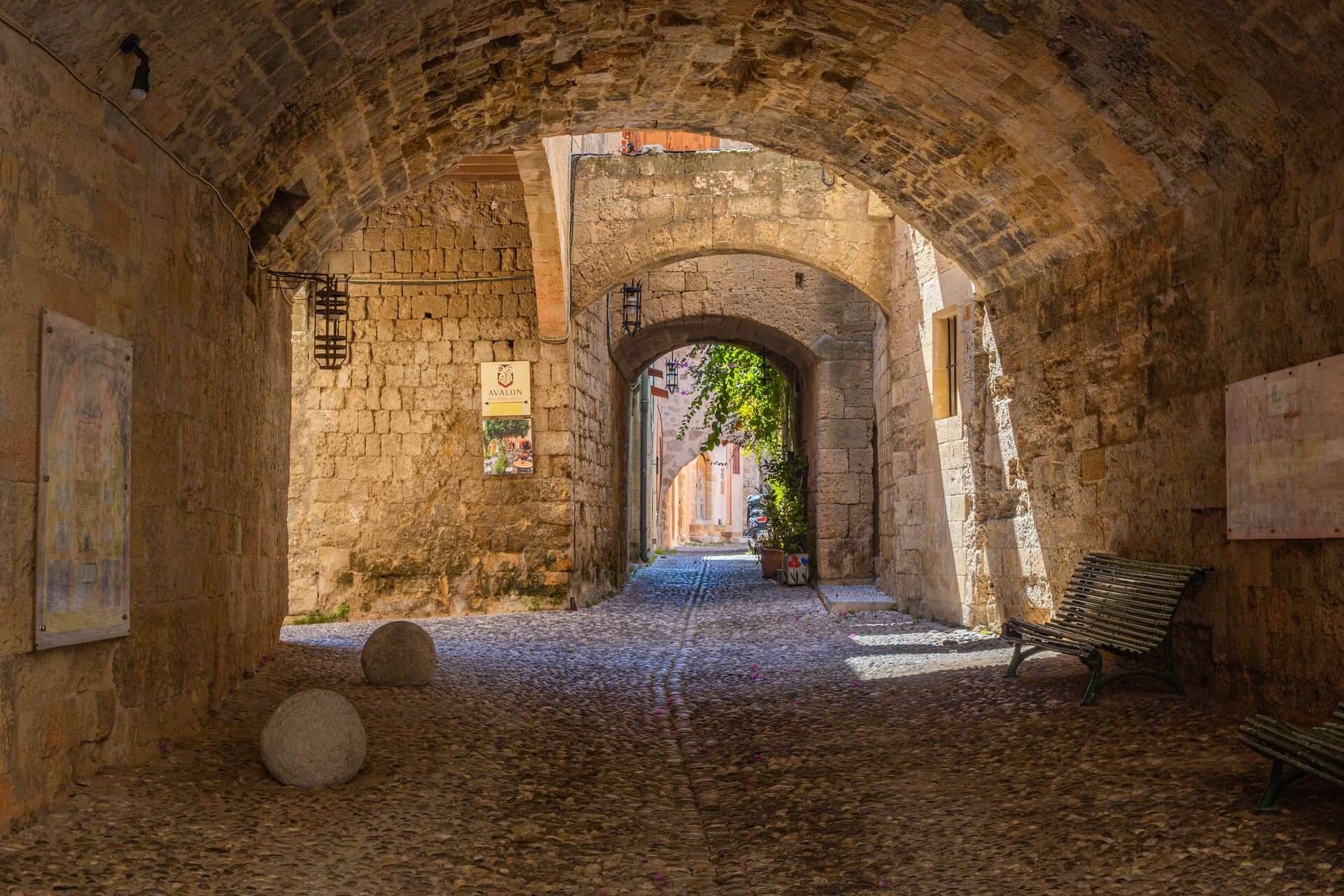
Rhodes, Old Town
Over the years, the Greek land’s opulence has become well-known around the world. Of course, Rhodes is no exception to the rule, providing its locals and Greeks in general with a wide variety of delectable and -in most cases – nutritious food. The products of Rhodes are intertwined with the history and culture of the island. Local honey and pasta, traditional jams, and PDO wines are part of the traditional treasure.
Grains, olives, and wine are the three pillars of the Mediterranean diet in Rhodian cuisine, with legumes and dairy products rounding out the list. When combined with other fresh raw materials from the fertile Rhodian land like groats and different types of pasta made from wheat, the above materials have produced foods that are particularly popular on the island, such as nutritious and tasty dishes. Rhodes cuisine is notable for its heavy use of cumin, which is not common elsewhere in Greece – at least not to the same extent.
Pickled caper leaves, local cheese called mizithra, various olive oils, and rich local honey are just a few of my favorite Rhodes flavors. Rhodes has some of the best varieties of these products in Greece, and they’re definitely worth a taste.
It is a well-known fact that wine is deeply ingrained in Greek culture and history, dating back to the dawn of civilization. Even though winemaking as a craft has evolved, its roots and associated traditions and customs have not.
In the 7th century BC, Rhodes, the region’s naval capital, became the world’s largest wine trader, making it one of the first Aegean islands to achieve winemaking success. Rhodes and Kos are the only two Dodecanese islands that have established themselves as major players in the wine-making industry, although the random vineyard can be found on all of the other islands. The majority of Rhodes’ vineyards can be found either in the island’s basin or on the mountain’s slopes, Mount Atavyros being the most prominent.
Guide on How to Get Around on Rhodes Island
As Rhodes is Greece’s fourth-largest island (1,400 square miles), renting a car or motorbike is the best way to see all of the island’s attractions. Many beaches and major destinations are accessible via the Rhodes KTEL bus service.
The most popular way of getting around on the island is by taxi but it can be expensive. The bus is a cheaper option and it will take you everywhere. If you enjoy walking, you can always walk from one place to the other but make sure that you have comfortable shoes because there are a lot of hills and stairs.

If you decide to rent a car, you can do so at some different rental agencies or even reserve one online ahead of time and pick it up later. To rent a car in Europe, you’ll typically need to be at least 26 years old, and it’s strongly recommended that you purchase insurance as well.
You can book directly with the company you’re working with, or you can take advantage of some travel credit cards’ perks. Depending on the time of year, you can get a four-person unit for around €25 a day. You’ll also have to pay for the gas.
The Old Town’s narrow streets can be navigated with ease on scooters, which are ideal for quick trips to the beach. Depending on the rental company, they can cost as little as €20, but you’ll likely need to purchase additional insurance.
What are the Best Beaches on Rhodes?
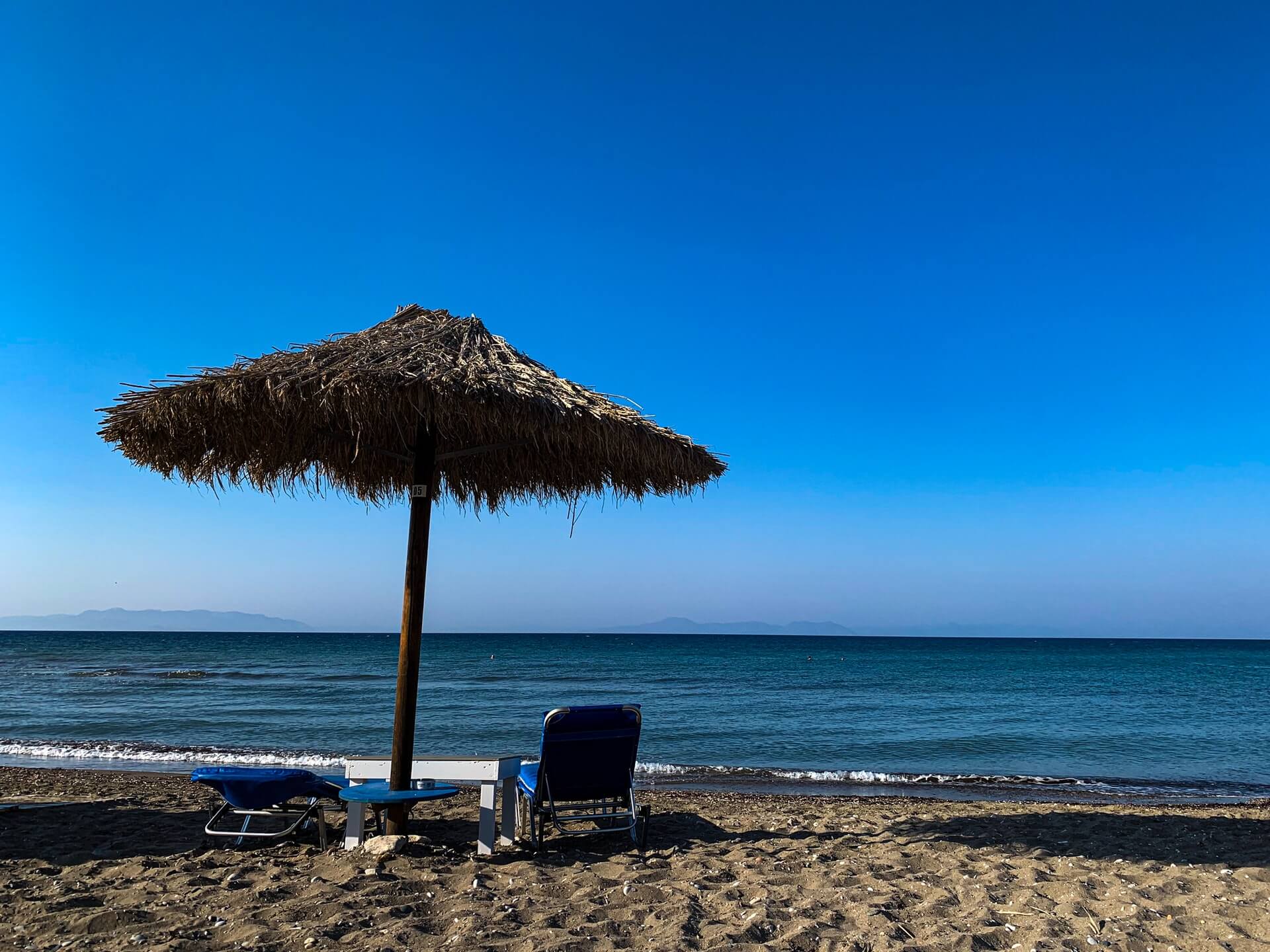
The island of Rhodes is one of the most famous tourist destinations in Greece. It offers beautiful beaches, amazing sunsets, and plenty of adventure activities. There is nothing better than relaxing on a beach and swimming in crystal-clear water if you are a beach lover. Then Rhodes is a fantastic cruise destination. Some of Rhodes’ best beaches, in order of popularity:
A fine sandy beach, Tsambika Beach is ideal for families with children. Sun loungers and parasols can be rented here, and you can participate in a wide range of nautical activities. This is a beach that looks like it’s straight out of a fairy tale.
This 800-meter stretch of fine golden sand is surrounded on three sides by steep slopes covered in garrigue and pines, adding to the beach’s natural beauty. Several rows of sun loungers and parasols can be accommodated on the beach, which is marked by flags with beach bars and restaurants. A watersports center is located on the beach if you tire of paddling in the shallow emerald sea.
Because it was a favorite of “Sorba the Greek” star Anthony Quinn, this beach has been named after him.
Both of the beaches in Saint Paul’s Bay, also known as Saint Paul’s Beach, offer stunning views of Lindos’ Acropolis. There are no public areas on the beach. A charming white chapel also serves as the site of a few weddings each year. What a lovely setting! A beautiful vantage point from which to take a bath. Relish in the view of Lindos Acropolis from St. Paul Beach while relaxing on your lounge chair.
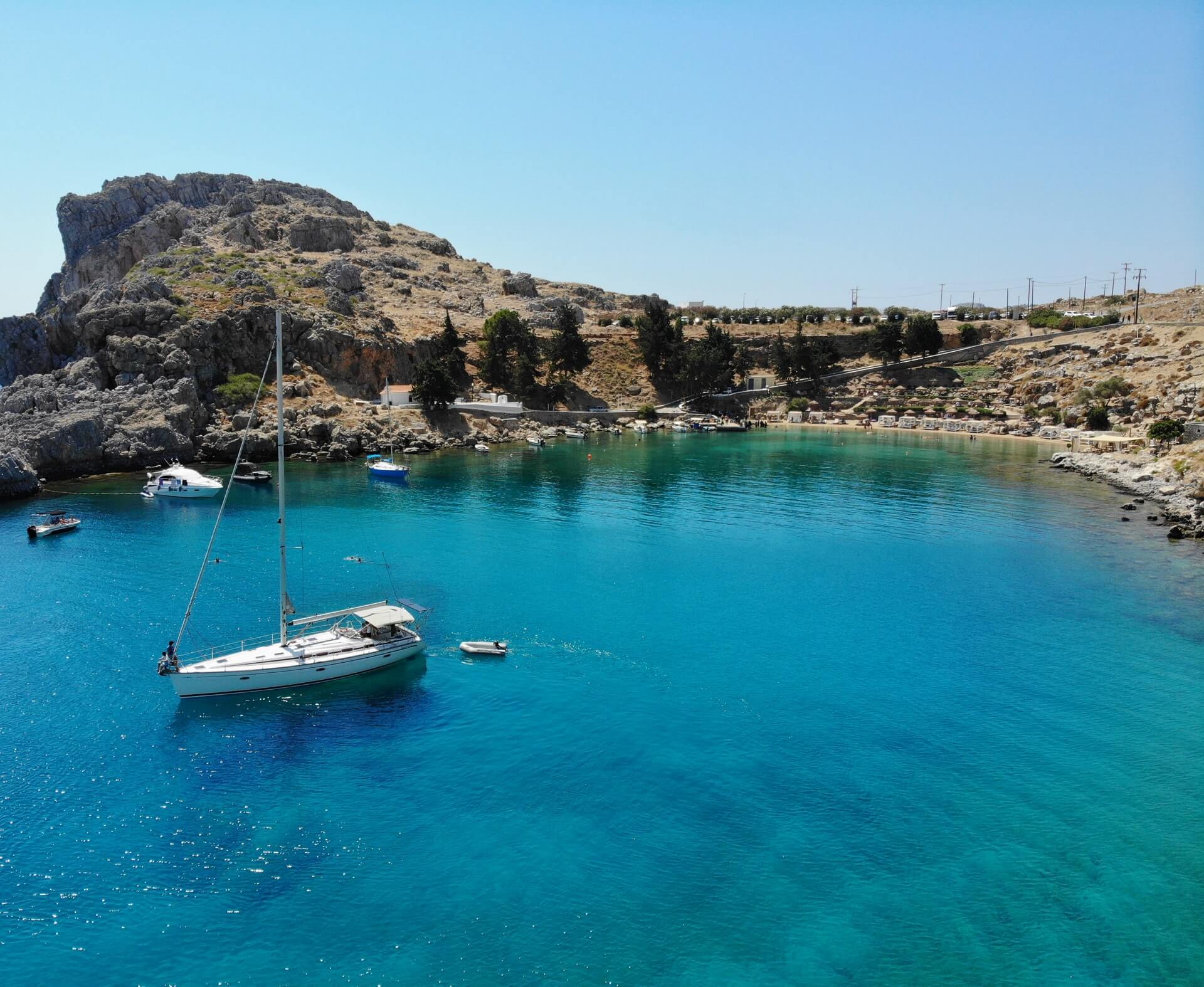
St Paul’s Bay, Rhodes, Greece
On the northeastern side of an ovular bay, there is only a small opening that leads to the main, sandy beach. A smaller pebble beach can be found just north of the acropolis, directly beneath the beach’s northern end. In the summer, when you’ll be sharing the beach with hundreds of people, both fill up quickly. However, this does not detract from the main attraction, which is the transparent sea, which is serene and shallow enough that even non-swimmers can relax in it.
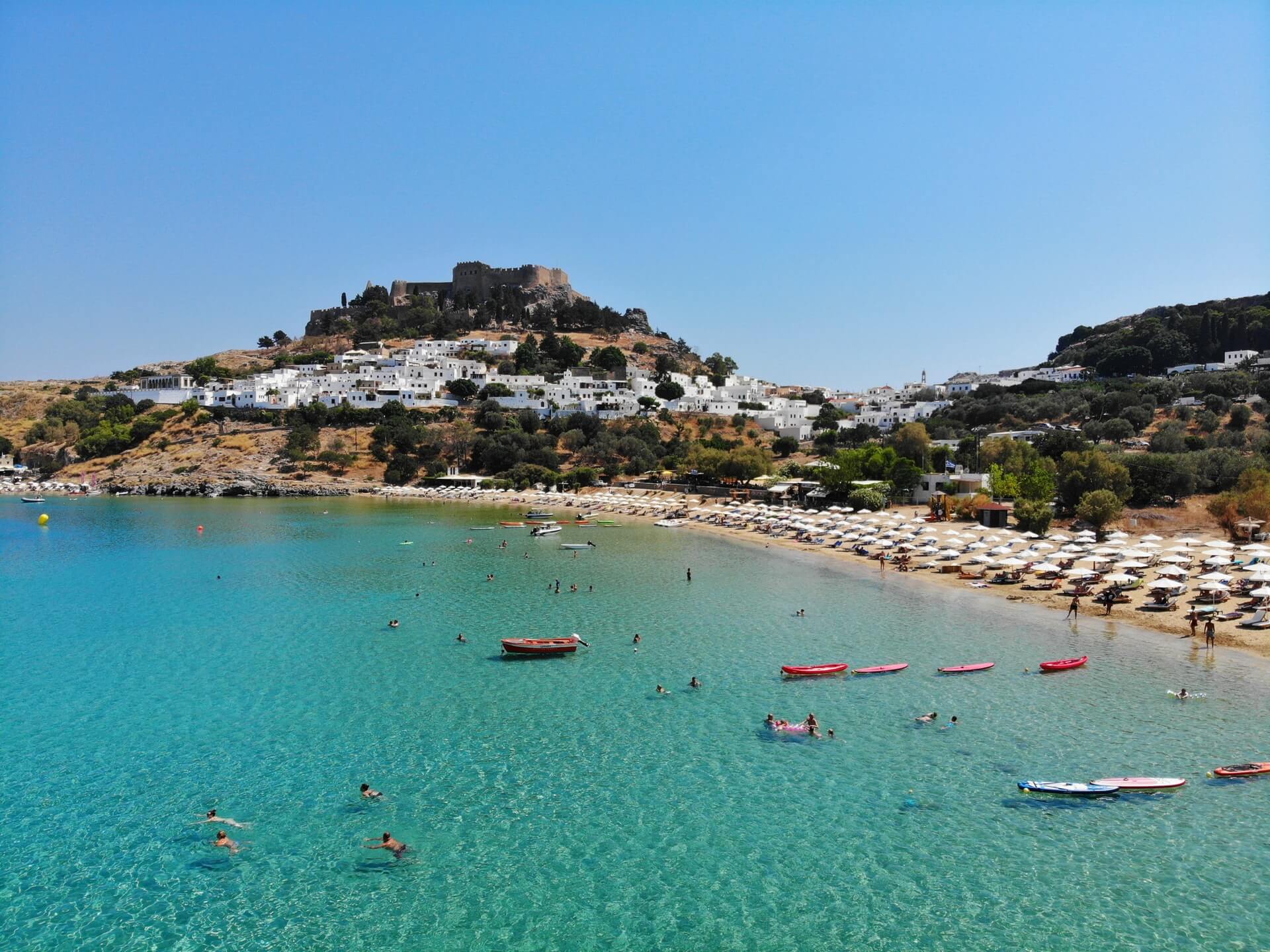
Town of Lindos at Rhodes, Greece
Rhodes City’s Faliraki Beach is about 10 kilometers south of the city. It is one of the island’s most popular and well-known beaches. There are numerous large, all-inclusive resorts in the area.
One of Rhodes’ best beaches is Prasonisi, which is located on the island’s southern coast. The Aegean Sea and the Mediterranean Sea are separated by this sandy beach. In addition to windsurfing, it’s a great place to know before visiting Rhodes , Greece! – The beaches of Lindos are tucked away below the town. After visiting the Acropolis, it’s clear that this is a great place to relax and enjoy a refreshing swim.
Is Rhodes safe to go on holiday?
The Greek island of Rhodes is a popular tourist destination. It is also the largest island in Greece and has been inhabited for more than 3,000 years. But should you visit it?
In 2016, the island was voted the most popular place to visit in Europe by Lonely Planet readers. However, there are some safety concerns that you should be aware of before visiting Rhodes, Greece this beautiful place.
The north of Rhodes has seen an increase in crime rates, with robberies taking place regularly. The south of the island is safer but still not without its dangers- it was hit hard by an earthquake in 2012 and there are still many buildings that need to be rebuilt following this natural disaster.



